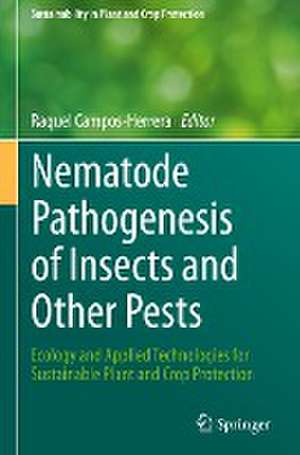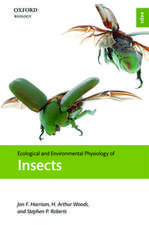Nematode Pathogenesis of Insects and Other Pests: Ecology and Applied Technologies for Sustainable Plant and Crop Protection: Sustainability in Plant and Crop Protection
Editat de Raquel Campos-Herreraen Limba Engleză Hardback – 22 aug 2015
| Toate formatele și edițiile | Preț | Express |
|---|---|---|
| Paperback (1) | 1055.81 lei 38-44 zile | |
| Springer International Publishing – 22 oct 2016 | 1055.81 lei 38-44 zile | |
| Hardback (1) | 1244.08 lei 3-5 săpt. | |
| Springer International Publishing – 22 aug 2015 | 1244.08 lei 3-5 săpt. |
Din seria Sustainability in Plant and Crop Protection
- 24%
 Preț: 794.96 lei
Preț: 794.96 lei - 18%
 Preț: 1126.59 lei
Preț: 1126.59 lei - 15%
 Preț: 648.24 lei
Preț: 648.24 lei - 24%
 Preț: 781.64 lei
Preț: 781.64 lei - 18%
 Preț: 1107.56 lei
Preț: 1107.56 lei - 24%
 Preț: 818.76 lei
Preț: 818.76 lei - 24%
 Preț: 810.45 lei
Preț: 810.45 lei - 24%
 Preț: 1053.51 lei
Preț: 1053.51 lei - 24%
 Preț: 792.90 lei
Preț: 792.90 lei - 20%
 Preț: 558.51 lei
Preț: 558.51 lei - 23%
 Preț: 579.82 lei
Preț: 579.82 lei - 24%
 Preț: 835.82 lei
Preț: 835.82 lei - 18%
 Preț: 944.67 lei
Preț: 944.67 lei - 18%
 Preț: 1380.98 lei
Preț: 1380.98 lei - 18%
 Preț: 951.91 lei
Preț: 951.91 lei - 18%
 Preț: 1229.28 lei
Preț: 1229.28 lei
Preț: 1244.08 lei
Preț vechi: 1517.18 lei
-18% Nou
Puncte Express: 1866
Preț estimativ în valută:
238.05€ • 249.21$ • 196.97£
238.05€ • 249.21$ • 196.97£
Carte disponibilă
Livrare economică 15-29 martie
Preluare comenzi: 021 569.72.76
Specificații
ISBN-13: 9783319182650
ISBN-10: 331918265X
Pagini: 500
Ilustrații: XVII, 531 p. 51 illus., 21 illus. in color.
Dimensiuni: 155 x 235 x 34 mm
Greutate: 1.2 kg
Ediția:1st ed. 2015
Editura: Springer International Publishing
Colecția Springer
Seria Sustainability in Plant and Crop Protection
Locul publicării:Cham, Switzerland
ISBN-10: 331918265X
Pagini: 500
Ilustrații: XVII, 531 p. 51 illus., 21 illus. in color.
Dimensiuni: 155 x 235 x 34 mm
Greutate: 1.2 kg
Ediția:1st ed. 2015
Editura: Springer International Publishing
Colecția Springer
Seria Sustainability in Plant and Crop Protection
Locul publicării:Cham, Switzerland
Public țintă
ResearchCuprins
1. Diversity, biology and evolutionary relationships.- 2. Improvement of entomopathogenic nematodes: a genetic approach.- 3. Behaviour and population dynamics of entomopathogenic nematodes following Application.- 4. Entomopathogenic nematode in the soil environment.- 5. Trophic relationships of entomopathogenic nematodes in agricultural habitats.- 6. Utilizing persistent entomopathogenic nematodes in a conservation or a more classical biological approach.- 7. Prospects in the application technology and the formulation of entomopathogenic nematodes for biological control of insects pests.- 8. Insect-cadaver applications: pros and cons.- 9. Entomopathogenic nematode application technology.- 10. Entomopathogenic nematode production and application: regulation, ecological impact and non-target effects.- 11. New York case study: biological control of Otiorhynchus ligustici with native persistent entomopathogenic nematodes using a more classical approach.- 12. Entomopathogenic nematodes in turfgrass: ecology and management of important insect pests in North America.- 13. It takes a village: entomopathogenic nematode community structure and conservation biological control in Florida (US) orchards.- 14. Entompathogenic nematodes in Cuba: from laboratories to popular biological control agents for pest management in a developing country.- 15. Entomopathogenic nematodes in tropical agriculture: current uses and their future in Venezuela.- 16. Orchard applications of entomopathogenic nematodes in Spain.- 17. Entomopathogenic nematodes in the Czech Republic: diversity, occurrence and habitat preferences.- 18. Entomopathgenic nematodes in Italy: occurrence and use in microbial control strategies.- 19. Entomopathogenic nematodes in iran: research and applied aspects.- 20. Entomopathogenic nematode exploitation: case-studies in laboratory and field applications from South Africa.- 21 Phasmarhabditis hermaphrodita as a control agent for slugs
Notă biografică
Dr Raquel Campos-Herrera is working on the ecology and biology of entomopathogenic nematodes since her PhD program in 2001, developed in the Spanish Council of Research (CSIC)-Universidad Complutense de Madrid. She received her PhD in 2006 with the Thesis entitled “The entomopathogenic nematodes from La Rioja and their symbiotic bacteria”, which was awarded with the European Mention and the Extraordinary Award as the best PhD in Zoology, Ecology and Botany in the University Complutense from Madrid. She has self-funded her whole career as young scientist, obtaining different fellowships and grants to support her PhD program (Spanish Ministry of Education, Culture and Sports, and post-graduate CSIC program) and the postdoctoral research at the University of Florida (USA) and Instituto de Ciencias Agrarias (ICA-CSIC) (Ramón Areces Foundation and Marie Curie International Outgoing Fellowships for Career Development). Recently, she joined the laboratory of Fundamental and Applied Research in Chemical Ecology (University of Neuchâtel) in October 2013. Here she develops the project “Applications of entomopathogenic nematodes for a sustainable control of soil insect pests”, granted by the Swiss National Science Foundation as part of the NRP68 “Sustainable use of Soil as a Resource”, appointed until March 2016. During her development as young researcher, she has participated in 11 national and european grants and was PI in two regional grants to study the entomopathogenic nematode biology and ecology for native Spanish isolates.
Textul de pe ultima copertă
One of the most challenging goals for modern agriculture is simultaneously reducing negative impacts on the environment while producing enough food. Sustainable agriculture is the alternative, using rational methods to protect crops and enhance productions. To accomplish this objective is necessary to link fundamental and applied research to advance towards the optimal use of the resources. The first volume of the Series “Sustainability in plant and crop protection”, presents a comprehensive and multi-disciplinary compendium about the recent achievements in the use of entomopathogenic nematodes (EPNs) and other nematodes as biological control in a global scale. Three sections comprise this volume to provide a holistic and up-to-date revision of different topics related with the use of nematodes as biocontrol. The fundamental bases on the biodiversity, genetic improvement, behavior, interactions in the rhizosphere and the conceptual model to their employ from augmentation to conservation biological control are discussed in the first section (Chapters 1-6). New approaches and techniques developed to enhance their efficacy and survival, enhancement of their release and the implications of regulation and ecological impact on the industrial scale production integrate the core of the second section (Chapters 7-10). The last section links the two previous ones in a worldwide case-study discussion. Long-term research programs and pioneer studies in countries with limited resources are integrated in this section (Chapters 11-20), including a special reference on the advances performed in the use of the slug parasitic nematode Phasmarhabditis hermaphrodita (Chapter 21). The contributors are renowned Scientific with long expertise in the selected topic. Their experiences illustrate the roadmap for the future generation of researchers interested inbuilt a new system in which sustainable agriculture will be the standard practice.
Caracteristici
The most novel compedium in applied entomopathogenic nematology, with special emphasis on the application of new technologies, molecular methods and global change impact data Contributions provided from world reference experts in the topics This book represents a model to provide a holistic approach linking ecology and biology with an agronomic perspective













